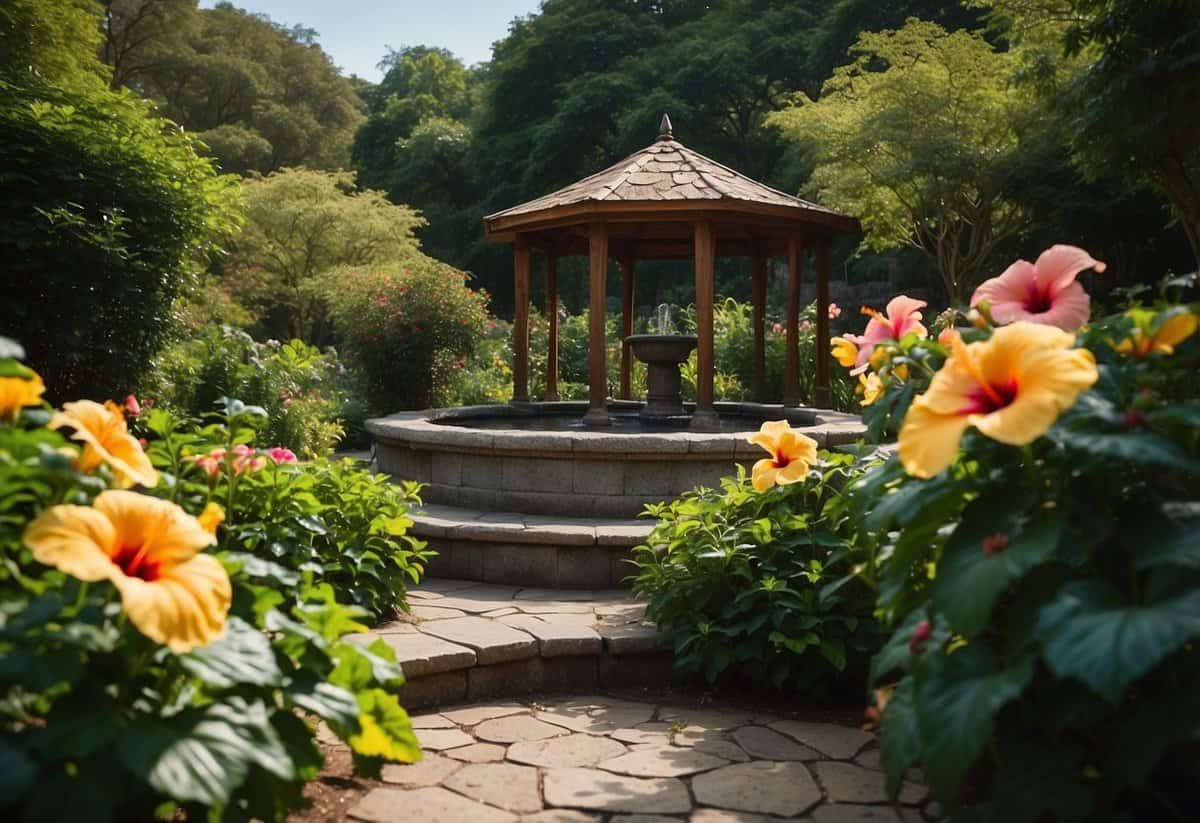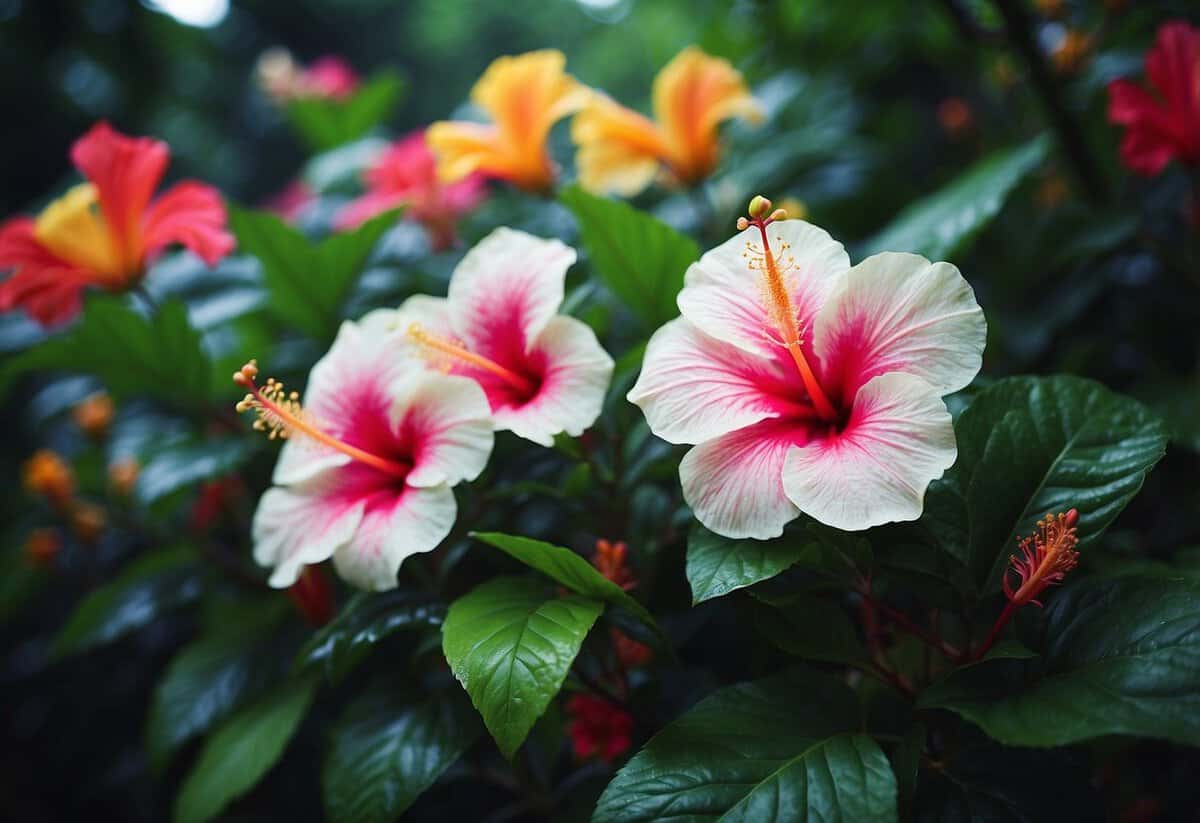Hibiscus Garden Ideas: Brighten Your Yard with Tropical Blooms
Creating a hibiscus garden can transform your outdoor space into a vibrant and colorful oasis. These striking flowers are known for their large, eye-catching blooms that can make any garden stand out. With a little planning, you can design a beautiful hibiscus garden that will impress all who visit.

How can you create a stunning hibiscus garden? Whether you are working with a small balcony or a large yard, there are plenty of creative ways to incorporate hibiscus plants into your environment. From understanding the best planting conditions to exploring various design ideas, this article will guide you in making your hibiscus garden truly shine.
1) Create a Hibiscus Hedge

A hibiscus hedge can add a burst of color to your garden. Choose from varieties like ‘Shanghai Pink’, which boasts rich pink flowers, or the ‘Double’, which changes from white to red.
Plant hibiscus in a sunny spot with well-drained soil. Space them tightly to create a dense, vibrant hedge.
Regular pruning will help maintain shape and encourage blooming. Enjoy the beauty and privacy your hibiscus hedge brings!
2) Hibiscus and Tropical Plants Mix

Pairing hibiscus with other tropical plants can create a vibrant garden. You might combine hibiscus with canna lilies. These lilies have bold, bright flowers that complement the hibiscus well.
Consider adding elephant ears. Their large, lush leaves make a great backdrop. Another option is hardy banana plants for a tropical flair.
For a more exotic look, think about bird of paradise. These striking plants can give your garden a lush, resort feel. The mix of hibiscus and tropical plants can turn your garden into an oasis. For more tips, visit Garden Design.
3) Hibiscus Flower Bed

Creating a hibiscus flower bed can transform your garden into a vibrant, colorful space. Choose well-draining, slightly acidic soil to help the hibiscus thrive.
Plant your hibiscus in a sunny spot, as they love lots of sunlight. Adding companion plants like daylilies or grasses can enhance the beauty of your flower bed. For inspiration, consider ideas from Breck’s Flower Bulbs.
Proper spacing and regular watering will keep your hibiscus looking lush and healthy. Enjoy the stunning blooms all season long!
4) Potted Hibiscus on the Patio

Place 1 to 2 inches of potting soil in the bottom of a container. Make sure the plant’s root ball sits 1 to 2 inches below the rim. Add more soil around the sides and firm it.
Fertilize your potted hibiscus once every 2 weeks during the growing season. This helps encourage more blooms and keeps the plant healthy.
Position your potted hibiscus where it gets at least 6 to 8 hours of sunlight per day. In very hot climates, consider giving it some afternoon shade.
5) Hibiscus in Hanging Baskets

Hibiscus can look beautiful in hanging baskets. These tropical flowers add a pop of color and are easy to care for.
Place your basket in a spot where it gets at least six hours of sunlight. Afternoon shade is helpful if you live in a hot climate.
Use well-draining soil to keep your hibiscus happy. Regular watering and monthly fertilizing during the growing season will boost flower production.
6) Hibiscus and Ornamental Grasses

Pairing hibiscus with ornamental grasses can create a stunning garden display. The bold, colorful blooms of hibiscus contrast beautifully with the soft, flowing texture of grasses.
Hibiscus like ‘Midnight Marvel’ boast large, scarlet red flowers. Grasses such as pampas or switchgrass add height and movement to your garden.
Choose grasses that can thrive in the same conditions as hibiscus. Both plants generally prefer well-drained soil and plenty of sunlight. This combination offers both visual interest and a long blooming season.
For more ideas, visit this late season border idea.
7) Hibiscus as a Focal Point

Using hibiscus as a focal point in your garden can create a striking visual impact. These plants have large, colorful flowers that catch the eye.
Place your hibiscus in a central spot where it’s easily visible. This can be in the middle of a flower bed or at the end of a pathway.
Hibiscus can also add a tropical feel to your garden. Just ensure it gets full sun and well-draining soil for the best blooms. For more tips, check out the 11 Tips for Growing Hibiscus in Containers.
8) Hibiscus and Butterfly Garden

Creating a hibiscus and butterfly garden is a wonderful way to attract wildlife while enjoying beautiful blooms. Butterfly bushes are great companions for hibiscus. They add texture and come in colors like pale pink, lavender, and lilac.
Plant both in well-draining, moist soil. Hummingbirds, butterflies, and bees will love the bright colors and sweet nectar of your hibiscus.
Daylilies also pair well with hibiscus. Their colorful blooms and similar growing needs make them perfect for a vibrant, lively garden.
Add some beneficial insects like ladybugs to keep your plants healthy.
9) Hibiscus Border Along the Pathway

Creating a hibiscus border along your pathway can add a vibrant and welcoming touch to your garden. Plant hibiscus in rows to create a stunning display. Their bright flowers will guide visitors through your garden.
For a fuller look, add colorful annuals or creeping groundcover between the hibiscus plants. This will help fill in any gaps. Floral walkways with low-growing foliage can also enhance the visual appeal.
Choose varieties like Hibiscus ‘Midnight Marvel’ for dark foliage and large, red blooms. These will provide a striking contrast to the green leaves and other plants.
10) Container Garden with Hibiscus

Growing hibiscus in containers can add vibrant color to your garden or patio.
Start by choosing a pot with good drainage to prevent waterlogging. Hibiscus prefers well-draining soil that’s rich in organic matter.
Place your hibiscus where it can get full sun for at least six to eight hours a day.
During the growing season, fertilize once or twice a month to encourage blooming.
In colder climates, move your hibiscus indoors during the winter to protect it from temperatures below 45 degrees Fahrenheit.
For more tips, check out this guide.
The Beauty Of Hibiscus Gardens

Hibiscus gardens bring vibrant colors and unique blooms to any outdoor space. The following sections highlight why you should choose hibiscus and the distinct aesthetic appeal these flowers offer.
Why Choose Hibiscus?
Hibiscus plants are a great choice for your garden because they are both beautiful and versatile. They thrive in various climates and soil types. These plants are easy to care for, needing just enough water and sunlight to flourish.
Hibiscus flowers can create a tropical vibe in your garden. They are perfect for containers, small gardens, and large landscapes alike. With many varieties, you can choose the best type of hibiscus to match your space and style.
Additionally, hibiscus blooms attract pollinators such as butterflies and hummingbirds. This can enhance the ecological health of your garden. The flowers can also bloom for several months, offering long-lasting beauty.
Aesthetic Appeal Of Hibiscus Flowers
Hibiscus flowers are known for their large, bright blossoms. They come in a range of colors like red, pink, yellow, and orange. Each blossom can have unique patterns and shades, making them stand out in any garden setting.
The petals of hibiscus flowers often have a velvety texture that adds depth and richness to their appearance. Their bold colors can brighten up your garden and create striking focal points.
Hibiscus flowers can bloom from summer well into the fall. Their size and vibrancy make them ideal for creating floral displays. When planted together, they can form stunning, colorful backdrops.
Their unique appearance and variety of blooms make hibiscus a beloved choice for garden enthusiasts. They can transform your outdoor space into a vivid, visually appealing area.
Planning Your Hibiscus Garden

To create a thriving hibiscus garden, you’ll need to choose the right varieties and find the best location in your yard.
Selecting The Right Hibiscus Varieties
When choosing hibiscus varieties, consider your local climate. Tropical hibiscus thrives in warm, frost-free regions, while hardy hibiscus can tolerate colder temperatures.
Look for plants with vibrant flowers and strong growth habits. Hibiscus ‘Midnight Marvel’ is a popular choice, known for its dark foliage and deep red blooms. Another option is Hibiscus syriacus, which blooms in various colors and can be shaped into trees or shrubs.
Also, think about the size of the plant. Some hibiscus varieties grow tall and wide, perfect for privacy screens, while others stay compact, suitable for containers or small garden spaces.
Choosing The Best Location
Hibiscus plants need a spot with full sun to bloom best. They can handle some shade, but too much will reduce flowering. Ensure the location has at least 6 hours of direct sunlight each day.
The soil should be well-draining but retain moisture. Sandy or loamy soils work well, but you can amend heavier soils with compost. Hibiscus prefers slightly acidic to neutral pH levels.
Place taller varieties towards the back of garden beds to create layers. This setup not only looks appealing but also helps shorter plants get enough sunlight. Also, ensure good air circulation to prevent fungal diseases.
For more detailed guidance on hibiscus care, visit Gardenia.
Care And Maintenance Of Hibiscus Plants

To keep your hibiscus thriving, focus on proper watering, suitable soil conditions, and pest control. These steps help ensure healthy, blooming plants.
Watering And Soil Requirements
Hibiscus plants need consistently moist soil with good drainage. Water your hibiscus regularly, making sure the soil stays damp but not waterlogged. Aim for about 1 inch of water each week, whether from rain or irrigation.
Soil quality matters. Well-draining, loamy soil is ideal to prevent root rot. If you have clay-heavy soil, mix in coarse sand to improve drainage and add organic matter like compost to raise soil acidity. For potted hibiscus, use a mix of potting soil and perlite to create the right environment.
Regular fertilization helps too. Feed your hibiscus twice a month during the growing season with a balanced, water-soluble fertilizer to encourage growth and blooms.
Pest And Disease Management
Keeping your hibiscus pest-free is crucial. Common pests include aphids, spider mites, and whiteflies. Inspect your plants regularly for signs of these insects. If you find any, wash them off with a strong spray of water or use insecticidal soap.
Diseases can be a problem too. Hibiscus plants are susceptible to diseases like leaf spot and powdery mildew. To prevent these, avoid overhead watering and ensure good air circulation around the plants. Remove any affected leaves to prevent the spread.
For severe infestations or persistent diseases, consider using a suitable fungicide or pesticide. Follow the instructions carefully to avoid damaging your hibiscus. Regularly cleaning up fallen leaves and debris can also help reduce the risk of disease.







